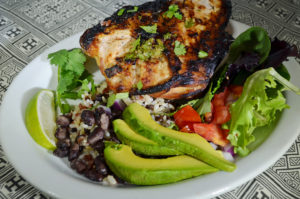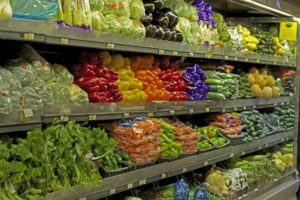Don’t Dig Your Grave With Your Own Knife & Fork
Don’t Dig Your Grave With Your Own Knife and Fork.
~English Proverb
Today, this proverb is very appropriate. Our quality of life has greatly decreased and little by little due to lack of nutrients we are shortening our life span.
And today, in our modern times we are inundated with food information and marketing making it difficult to understand what it means to eat healthy.
Terms like low fat, low carb, high protein, gluten free, grain free, vegan, vegetarian make it even more confusing to understand how to eat right.
How about balance? We’ve heard the term “eat a balanced diet”, but even that is vague and confusing.
Let’s break it down and explore the 7 things you must know before spending your hard-earned money on food and learn to truly eat right. I want to empower you to make the best food choices and help you live a long, good quality life! Knowledge and information is power.
-
Food; Medicine or Poison ?
What does it mean to Eat Right? Eating right doesn’t have to be complicated, but with all the fad diets, big food companies, food labels, and food controversies, it can be a tad confusing.
Understanding the food you choose to eat, and how it affects your body is important. After all, it is going to make or break you. Literally. Every bite you take has an impact on your body. It will either feed and repair your cells, or cause damage to your cells. Unhealthy food choices can cause and contribute to chronic conditions, thyroid imbalance, diabetes type 2, autoimmune disease, cancer, mental health conditions, poor sleep, poor memory, the list goes on.
Who or what influences you in terms of your food choices?
Do food advertisements impact your decisions?
Are food labels an important part of your decision?
Do you choose food based on their nutrient value?
Do you understand the impact of processed foods or food additives on your body? These are important questions and answering these questions will certainly assist you in eating right.
If we took a little time to understand what our bodies need to stay healthy and strong and which foods harm us, we would be equipped with the knowledge to make healthy choices.
Eating right in a nutshell:
Eat quality protein
* Pasture raised chicken and eggs
* Pasture raised beef
* Wild-caught fish
* Legumes, nuts, and seeds
Eat quality complex carbs:
* Leafy greens
* Variety of fresh (or frozen) vegetables
* Variety of fruit
* Grains (sparingly)
Eat healthy fats:
* Wild-caught salmon
* Avocados
* Olives
* Avocado and olive oils
* Nuts & Seeds (walnuts and flaxseeds)
* Whole fat dairy, or butter (sparingly)
Spices & Herbs:
Rely on a variety of spices and herbs to flavor your foods. Not only do they offer superb flavors, but the health benefits are immense as well.
Need some ideas? Click here for some healthy recipes.
2. Food Companies & Miserly Marketing
Food companies are in the business of making money. Our health is not their concern. There are basically 10 large food companies that dominate the world, feed the world, and vie for your money.
“…making sure everyone always has enough nutritious food to eat has not been the focus of these powerful members of the global food system. For the past century, the food and beverage industry has used cheap land and labor to produce the least expensive products possible – often of low nutritional value – while maximizing profits…” Oxfam, Behind the Brands
Yikes, with reviews like that, it is hard to imagine that we all give our money so willingly to these food companies…yet we do!
Food companies use marketing and rely on advertising to get your dollars. Food labels are an effective marketing ploy for food companies.
We see the words “healthy”, “all natural”, low fat”, “clinically proven”, “no hormones added”, “whole grain” “no sugar added” “real fruit juice” the list goes on and on.
What do these labels really mean? Not much.
Food companies try to gain our trust by adding catchy terms to convince us that their foods are necessary for our health. Typically, if a food is processed and made in a manufacturing plant, it is low in nutritional value regardless of what the label states.
An example of how food labels trick you is the labeling of chicken. By law, chickens cannot be treated with hormones. Some chicken packages are very prominently labeled: “No Hormones Added” leaving you to believe that you are buying something special when in fact chickens can’t be given hormones. What you need to look for is chicken that specifically states “No Antibiotics”, “Organic” or even better “Pasture Raised”.
Chickens are inundated with antibiotics, contributing to the scary antibiotic-resistant bacteria strains that are now popping up in humans.
My thoughts: If a food company has to make lots of claims to try to convince you to buy their product, it probably isn’t a healthy food. If you have to read a long food label and decipher it, it probably isn’t a food that will feed your body and cells.
3. USDA’s Reckless Recommendations
I wish the USDA had our best interests in mind when making the Food Plate, but sadly, it is money-driven. The Food Plate is not science-based. Each food industry vies for space on the food plate so they can keep their industry going regardless of the facts.
Many of us remember the food pyramid from the 90’s with lots of bread, pasta, bagels, and crackers splashed across the bottom with a suggestion of 6-11 servings per day! Wow, was that advice wrong! We now know and understand how this recommendation contributed greatly to many chronic disorders now faced by 45% of Americans.
Food Pyramid 1992
“The clearly wrongheaded advice to load up on carbohydrates had proven a major government mistake.” ~ The Weston A. Price Foundation
In 2011 MyPlate diagram, issued by the USDA, was established. According to myplate.gov, MyPlate diagram is:
“An Icon that serves as a reminder for healthy eating, not intended to provide specific messages”.
Since 1980, when the USDA introduced its first “Dietary Guidelines for Americans”, collectively as a nation, we have had an exponential development of chronic conditions such as; diabetes type 2, autoimmune disorders, cancer, and digestive disorders.
Below are two examples of food guidelines. Harvard’s Healthy Eating Plate is much more detailed and much closer to how we should be eating. There is much controversy about the USDA’s MyPlate being influenced by food lobbyists rather than science.

Harvard Eating Plate

USDA MyPlate
My thoughts: I believe we are still being misled when it comes to the grains section of MyPlate. Most people will continue to eat highly processed, sugar-filled grains, believing it is a healthy choice. Following Harvard’s Healthy Eating Plate might be a better choice for guidance.
We would probably be better served if we were advised to simply eat the following:
* Quality Protein: pasture-fed chicken, eggs, beef, wild-caught fish, and legumes.
* Complex carbs: a variety of leafy greens, vegetables, and fruits.
* Healthy fats: Nuts, seeds, olive oil, salmon, avocado.
What about grains, you might ask? Grains can be a healthy part of a diet, but not a necessity. And for many people, it may just be downright unhealthy. Here’s what Dr. Hyman has to say about grain:
“Grains– For millions of Americans gluten creates inflammation, autoimmunity, digestive disorders and even obesity. But do all grains cause a problem? Even though we started consuming grains recently in our evolutionary history, they can be part of a healthy diet, but not in unlimited amounts.”
4. Significant Supplements
A few words about supplements. In many cases, supplements can be beneficial. However, supplements, just like our food, need to be made with real food. For our bodies to properly absorb the nutrients in supplements, they need to be whole, plant-based, high-grade supplements. The supplement industry, just like the food industry is motivated by profits. Many supplement companies do not operate with integrity and sell inferior products. My blog on how to choose supplements – coming soon!
Click here to shop. Wellness programs, CBD products, supplements and more. My supplement store is always *15% off*. Choose from hundreds of top-brand, high-quality supplements. I only offer the best products I can find.
*15% off does not include CBD products and wellness programs.
5. KISS Your Food
Rather than trying to follow complicated fad diets, which can include counting calories, assigning points to foods, drinking shakes instead of meals, juicing all day, and other odd things, just KISS your food!
Keep
It
Simple and
Straightforward.
* Ditch foods that make wild promises.
* Avoid foods with nutrition labels as long as this blog, and filled with additives.
* If a food causes discomfort: rashes, bloat, gas, headaches, joint pain etc, don’t eat it.
* Eat foods grown in the earth, fed on pasture, and fished out of the ocean.
Next time you visit the grocery store challenge yourself to spend less time in the aisles and more time around the outer perimeter. The perimeter of a grocery store is where all the fresh food is. Spend more time in the produce section. Buy a couple of vegetables you’ve never had before and experiment. Above all keep it simple.
6. Fad Diets, Counting Calories, Diet Pills
Fad diets and calorie counting typically don’t work.
Why?
To sustain health or weight loss, a plan must be something you can do for life. If you lose weight through a diet that constricts most foods by using meal replacement shakes, or weeks of juicing, when you go back to your “normal” way of eating, the weight will come back. This goes for reversing health issues as well. Change must be slow, steady, and done in ways that are sustainable for life.
All calories are created equal….NOT
The problem with counting calories is that every calorie is not created equally, despite what we’ve been told for years. A calorie from protein, healthy fat, or complex carbs, such as vegetables and fruit will metabolize much differently than a calorie from a simple carbohydrate, such as white bread, pasta, or other processed foods.
Count Nutrients, Not Calories
The body takes high glycemic foods (foods that raise blood sugar levels quickly) such as pasta, breads, and flours and stores it as fat. The body uses the same calories in protein, fats, and complex carbs for energy. Plus the nutrients in protein and complex carbs are far superior to that of simple carbs. In some cases, you can even increase your caloric intake while decreasing your carb intake and still lose weight.
Cleanses, detoxes, juice fasting, or other temporary fasting is fine from time to time, but remember, if you use any special diet to lose weight or reverse illness, it must be something you can do for a lifetime or you are setting yourself up for failure.
7. Insufficient Sugar
While eating right is essential to a strong immune system, healthy body, and mind, and maintaining a healthy weight, we are still human and humans want and crave fun, sweet foods, and treats. But, we need to consume in moderation. Processed foods are adding to our over-consumption of sugar. Take a look at the ingredients of some of your favorite foods.
Watch for words like:
- sucrose
- dextrose
- fructose
- corn syrup
- lactose
- maltose
- invert sugar
- malt syrup
- fruit juice syrup.
Sugar provides zero nutrients to our bodies. Sugar can cause and contribute to many chronic conditions and disorders, including but not limited to autoimmune disorders, diabetes type 2, IBS, digestive disorders, high blood pressure, certain cancers, weight gain, and heart disease.
According to University of California San Francisco,
“Americans consume 66 pounds of added sugar each year, on average.”
That amounts to over 1 pound of sugar per week!
One final thought: Today there are many different styles of eating: vegan, vegetarian, lacto-vegetarian, ovo-vegetarian, paleo, keto, and omnivore (to name just a few) and many claim that one is superior to the other.
Truth: You need to eat for your body type, your beliefs, and you need to eat what works for you. If you choose to eat meat, poultry, or fish and work on eating sustainable, grass-fed, properly raised, wild-caught, and you eat it in moderation, then you are doing no harm to your body. In fact, there are some nutrients that can only be obtained through animals and fish. If you choose vegan or vegetarian, as long as your diet consists mostly of vegetables and not grains or processed foods, and you add supplements (primarily B12 and Omega-3) you are getting much-needed nutrients. We have to choose what is right for us without feeling pressured or guilty. You will find that simply decreasing processed foods and sugar and eating more whole fresh foods will help you better achieve your health goals than most fad diets.
I hope you now have an understanding on how eating right can be simple, and what “healthy” food really looks like. Share your thoughts in the comments section. How do you maintain your health?
Cheers To Your Health!
Deb, CHC
Certified Health Coach & Holistic Health Practitioner
Always speak to your doctor before making any dietary changes. The information on this page is not evaluated by the FDA and is not intended to diagnose, treat, cure, or prevent any disease. Click for full disclaimer.
Like what you read? Share and Sign up to get the latest healthy recipes and health updates.
Sources:
https://www.oxfam.org/sites/www.oxfam.org/files/bp166-behind-the-brands-260213-en.pdf
http://www.huffingtonpost.com/2014/08/17/companies-control-food_n_5684782.html
https://www.westonaprice.org/health-topics/dietary-guidelines-from-the-usda/a-closer-look-at-my-plate/
https://www.choosemyplate.gov/
http://www.eatright.org/resources/
https://www.hsph.harvard.edu/nutritionsource/healthy-eating-plate-vs-usda-myplate/
http://ucsdnews.ucsd.edu/feature/recipe_for_wellness
http://articles.mercola.com/sites/articles/archive/2011/08/13/many-restaurants-underestimate-calories-in-their-dishes.aspx
https://www.forbes.com/sites/michaelpellmanrowland/2016/11/02/the-food-pyramid-of-the-future/#49e9a364da3e
http://drhyman.com/blog/2014/11/07/pegan-paleo-vegan/
http://sugarscience.ucsf.edu/hidden-in-plain-sight/#.WnnlIugbPIU
https://drhyman.com/blog/2016/01/22/is-meat-good-or-bad-for-you/













Leave a Reply
Want to join the discussion?Feel free to contribute!